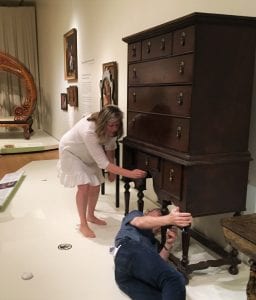The Storytellers of WPAMC
By Eliza West, WPAMC Class of 2019

Nicholas Bell (WPAMC ’08), Senior Vice President for Curatorial Affairs at Mystic Seaport, shows a drawer of scrimshawed whale teeth to the class of 2019. After discussing Kate Budzyn’s research into erotic postcards, the group examined the scrimshaw for similar iconography, in hopes that these objects might play a useful role in telling another story. Photo by Dr. Wendy Bellion.
During both of our final stops on the WPAMC class of 2019’s Northern Trip, we had the chance to meet and talk with alumni of the program. At the Peabody Essex Museum in Salem, Massachusetts, we toured the galleries with H.A. Crosby Forbes Curator of Asian Export Art, Karina Corrigan (WPAMC ’97). The next morning we met with Nicholas Bell (WPAMC ’08), Senior Vice President for Curatorial Affairs at Mystic Seaport Museum. Both Karina and Nicholas urged us to understand our education at Winterthur as a way of learning to look at the world and the objects that populate it, in order to hear the stories they have to tell. For both of these alums of the program, their jobs are less about being specialists in certain materials or cultures, and more about understanding what it takes to share an object’s story with an audience in a meaningful way.

Karina Corrigan (WPAMC ’97), the H.A. Crosby Forbes Curator of Asian Export Art at the Peabody Essex Museum, and Greg Landrey, Winterthur’s Director of Academic Affairs, explore an eighteenth-century highboy made of Chinese hardwood, which displays both European and Asian construction techniques, suggesting a unique story of creation. Photo by the author.
At the end of a week of travel and study, this message hit home for me. We had started our trip in Woodbury, Connecticut, with a visit to the Hurd House, which was built in the seventeenth century and still stands on its original foundation. This is the house’s claim to fame, and so often this is the story it is asked to tell. We, however, experienced the Hurd House differently. Winterthur’s Director of Academic Affairs, Greg Landrey, was one of our leaders for this trip, and he asked us to think about how Hurd house could also tell the stories of the generations that had lived in it well into the twentieth century. He did this by explaining that the Hurd house was not only one of Connecticut’s remaining seventeenth-century homes, it was also his family’s home for over a hundred years. By drawing this personal connection, Greg helped us to think about the further stories that Hurd House had to tell.

The WPAMC Class of 2019 stands outside the Hurd House in Woodbury, CT, with Winterthur Director of Academic Programs, Greg Landry. Photo by Dr. Wendy Bellion.
A few days later our class toured the Boston Athenaeum, one of the country’s oldest libraries, and the home of an impressive art collection. On our tour we had a chance to explore not only books, paintings, and sculptures, but also the Athenaeum’s beautiful interior architecture. One of the spaces we visited was the board room, and it was there that we found yet another object with stories waiting to be told. In the middle of the room was a conference table which was fully six feet wide, and twice that size in length. As our tour guide talked to us about the art on the walls, something about the table caught the eye of one of my classmates. There were no seams in the table’s top; it was a single board which had been sawn from a gargantuan tree.

The glowing surface (not to mention undersurface!) of this magnificent table drew the eyes of students and instructors alike during our visit to the Boston Athenaeum. Photo by the author.
As is the habit of Winterthur fellows, a few of my classmates dove under the table, keen to see what the unfinished undersurface could tell us about this object. From beneath the table emerged oohs and ahs, amid stray beams of raking light. Our tour guide kindly took this in stride, though it was clear that most visitors to the Athenaeum did not lavish this sort of attention on the furniture. To me this was an example of the idea that both Karina and Nicholas had championed: we were looking for the hidden stories the table had to tell. Though we didn’t have long to look, our best guess was that the table dated to the nineteenth century (based on the style of its legs) and that the magnificent tree which had yielded up the table top was Chinese hardwood. Since that visit, I’ve enjoyed the challenge of thinking about what the story of that table might add to the Athenaeum’s history. As I head into my second year, I’m reinvigorated to tell the stories of objects both within and outside of Winterthur’s collection.

Leave a Reply